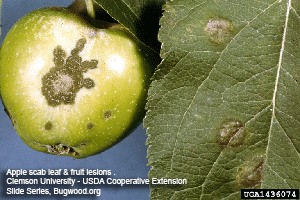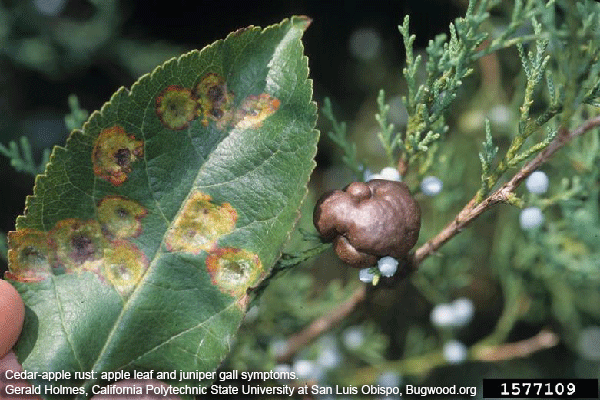Whenever eastern Nebraska has an extended cool, wet spring gardeners see increased infection from apple scab and cedar-apple rust. Healthy trees can tolerate periodic infections with little long-term damage, but repeated severe infections can reduce tree vigor and health. Good tree management techniques will help reduce the incidence of these diseases in your trees. And if your trees have suffered serious repeated infections, then fungicidal control may be beneficial.
Apple scab overwinters on bits of infected leaves and fruits. Mature fungal spores are released into the air during periods of spring rain and blown to nearby trees. Cedar-apple rust overwinters on its secondary host – juniper. Gelatinous orange fruiting structures develop on junipers during wet spring weather and disperse fungal spores to susceptible apple hosts.
Spores that land on a leaf or fruit and come in contact with water germinate and cause infection. That's why disease development is favored by wet, humid weather, which is common from late April through June.
 Symptoms
Symptoms
Cedar-apple rust causes bright yellowish-orange leaf and fruit spots, which often have a band of red or yellow around the outer edge.
Apple scab causes olive to greenish-black leaf spots. Similar cracked, scabby spots appear on the fruits with heavily infected fruits becoming misshapen.
Control Strategies
There are several approaches to managing apple scab and cedar-apple rust, each offering some degree of success when used individually. The best long-term management, however, involves integrating multiple tactics, including the use of resistant varieties, sanitation, and chemical control.
Practice good sanitation by raking up and disposing of infected leaves and fruits to reduce old infected plant material and disease pressure next spring. If you didn’t cleaned beneath your trees last fall or yet this spring, there is still time to do it now. Rake up and destroy or discard last year’s infected leaves and fruits.
During the growing season, avoid wetting the leaves of apple and crabapple trees with lawn sprinklers. Make sure there is good air circulation among trees to ensure leaves dry as quickly as possible after rain or heavy dew. Tree placement and pruning can be used to improve air circulation.
Effective control using fungicides depends on the timeliness and repetition of applications, and the degree of coverage obtained on both the upper and lower leaf surfaces. Begin applications in spring at bud break and repeat applications as directed by the fungicide label. Typically 3-4 fungicide applications made 7-14 days apart are required for good control. Recommended fungicides include chlorothalonil (Daconil, Fung-onil, Ortho Garden Disease Control), thiophanate-methyl (Cleary’s 3336, Fungo), myclobutanil (Immunox, Eagle), mancozeb (Dithane, Fore, Protect) or propicopnazole (Banner Maxx, Infuse).
For a complete spray schedule for home orchardists, refer to the University of Missouri’s publication “Fruit Spray Schedules for the Homeowner”. Always read and follow all label directions and precautions.
When planting new trees, chose resistant varieties, although it can be difficult to find cultivars with inherent resistance to both diseases. However, in years with heavy disease pressure even resistant varieties may require occasional spraying to totally eliminate disease damage to the fruits.
The following apple varieties have shown moderate resistance, at a minimum, to both diseases.
- Apples – Akane, Belmac, Dayton, Enterprise, Freedom, Liberty, MacFree, Moira, Murray, Novamac, Paulared, Priscilla, Redfree, Runkel, Scarlet O’Hara, Sundance, Trent, William’s Pride, Wolf River and Yellow Transparent
Crabapples with resistance include the following
- Apple scab resistance – Bob White, Calocarpa, David, Jackii, Prairifire, Red Splendor, Sargent and Sugar Tyme
- Cedar-apple rust resistance – Adams, Adirondack, Beverly, Candied Apple, Dolgo, Donald Wyman, Indian Summer, Liset, Lollipop, Red Baron, Red Jewel, Robusta, Royalty, Sarget cv. Tina, Snowdrift, Special Radiant, Zumi

